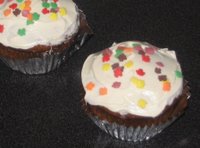 Lebkuchen is a form of gingerbread common in Germany. The difference between Lebkuchen and what we Americans typically think of gingerbread is it's made with honey instead of molasses, hence the lighter color. Lebkuchen was developed in the 13th century by Franconian monks though the development of the name Lebkuchen is still a mystery. The most likely explanation is it comes from the Latin word for a flat, unleavened loaf, libum. However the more popular (and less academic) belief is the name comes from the German word Leben, which means life. In fact, it is believed that eating these "life cakes" can chase away the winter blues.
Lebkuchen is a form of gingerbread common in Germany. The difference between Lebkuchen and what we Americans typically think of gingerbread is it's made with honey instead of molasses, hence the lighter color. Lebkuchen was developed in the 13th century by Franconian monks though the development of the name Lebkuchen is still a mystery. The most likely explanation is it comes from the Latin word for a flat, unleavened loaf, libum. However the more popular (and less academic) belief is the name comes from the German word Leben, which means life. In fact, it is believed that eating these "life cakes" can chase away the winter blues.The city most famous for its Lebkuchen is Nuremberg. Located on a major spice route, records show Lebkuchen was baked in Nuremberg since the late 14th century. Nuremberg Lebkuchen is a protected food product in Europe and its production is strictly controlled. The highest quality Lebkuchen of Nuremberg is given the title Elisen, supposedly named after a daughter of a Nuremberg baker.
This particular recipe uses crystallized ginger instead of the more common candied fruit. This change causes the spicy flavor of ginger to be strong in these bars. The bars themselves are dense but soft. The bars do rise slightly while baking but they will basically be the thickness you roll them out to be. If you try to roll them out thin like a sugar cookie I believe you would get a hard, dense cookie that might be tough to chew. The dough is sticky, very sticky. It was probably the toughest cookie/bar/etc. dough I've worked with yet. And there is the time factor. The dough must chill overnight in this recipe (and many others). I recommend that when chilling the dough, gently work it into a ball shape so only a small portion of the dough touches the bowl. It will be much, much easier to remove from the bowl the next day. Still, the rewards of this delicious bar outweighed the work involved.
Lebkuchen
from page 198 of the The King Arthur Flour Cookie Companion: The Essential Cookie Cookbook
Makes about 24 bars
3/4 cup (9 oz) honey
1/2 cup (4 oz) light brown sugar
1 large egg
2 tsp chopped lemon zest or 1/4 tsp lemon oil
2 tsp chopped orange zest or 1/4 tsp orange oil
2 1/4 cups (9 1/2 oz) unbleached all-purpose flour
1/4 tsp baking soda
1/2 cups (2 oz) finely chopped blanched almonds
2 tsp cinnamon
1 tsp ground ginger
1 tsp ground nutmeg
1 tsp ground cloves
3 rounded Tbls (1 3/4 oz) diced crystallized ginger
6 Tbls brandy
1 cup (4 oz) powdered sugar
Combine the honey and the brown sugar in a saucepan and bring to a boil while stirring occasionally. Once boiling, remove from heat and let it cool until it's only slightly warm. Using a food processor, chop the crystallized ginger until it is fine. Mix the honey-brown sugar mixture, egg, lemon zest or oil, and orange zest or oil in a large bowl until they are well mixed. Add in the spices, flour, crystallized ginger, baking soda, and almonds and mix until they are thoroughly mixed. This produces a stiff and very sticky dough. Very sticky. Cover the bowl, put in the refrigerator, and let sit overnight.
When you are ready the next day, preheat the oven to 350° F and grease a 9x13 inch or equivalent sized pan. Remove the dough from the refrigerator and place on a lightly floured surface. Roll out the dough to fit into the pan. The dough will be very sticky but try not to over-flour everything. Put the dough in the pan. I rolled it onto the rolling pin and then unrolled it in the pan. Fit the dough into the pan the best you can but don't press down too hard. I greased my fingers and that worked pretty well. Bake for about 20 to 22 minutes. In the meantime, mix the brandy and the powdered sugar. This glaze isn't very thick. The bars are down when a cake tester or toothpick comes out clean. Transfer to a cooling rack immediately and begin glazing. Apply the glaze in layers so each layer has time to soak in and harden. Once fully glazed and cooled, cut into 1x2 inch bars. If you store these in an airtight container with a slice of apple, they will stay soft.
Also on Just Baking.
Sources:
Lebkuchen at Wikipedia
German Embassy in Washington DC
Nuremberg Gingerbread Tour
The King Arthur Flour Cookie Companion: The Essential Cookie Cookbook
Germany's Regional Recipes
German Cookery: The Crown Classic Cookbook Series (Crown Classic Cookbook)
The German Cookbook: A Complete Guide to Mastering Authentic German Cooking
























 We had some baker's boxes to put them in and lined the bottoms with Halloween themed paper from the scrapbooking section of
We had some baker's boxes to put them in and lined the bottoms with Halloween themed paper from the scrapbooking section of 